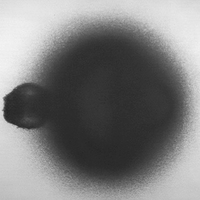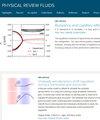液态 He4 在液气临界点附近的激光诱导空化
IF 2.5
3区 物理与天体物理
Q2 PHYSICS, FLUIDS & PLASMAS
引用次数: 0
摘要
在光学低温恒温器中使用帧速率高达 5×106 fps 的高速视频,研究临界点附近和超临界区域氦气中激光诱导空化的动力学。在这两种情况下都观察到了强冲击波的传播。空化气泡半径和气泡外声压场的时间依赖性由标准可压缩流动模型描述。在 4K<T<5.2K 的温度范围内,当主空化气泡接近其最大半径时,在气泡外观察到对称的微米级气泡云,这是由于气泡外低压流体中的均匀成核和旋光分解造成的。在远低于临界点的地方也能观察到次级气泡的成核现象,但这需要较大的负压,而主气泡反射的冲击波可以产生这种负压。本文章由计算机程序翻译,如有差异,请以英文原文为准。

Laser-induced cavitation in liquid He4 near the liquid-vapor critical point
High-speed videos in an optical cryostat, with frame rates up to fps, are used to study the dynamics of laser-induced cavitation in helium near the critical point and in the supercritical region. The propagation of strong shock waves are observed in both regimes. The time dependence of the cavitation bubble radius as well as the acoustic pressure field outside the bubble are described by standard compressible flow models. In the temperature range , a symmetric cloud of micron-scale bubbles are observed outside the main cavitation bubble as it approaches its maximum radius which is due to homogeneous nucleation and spinodal decomposition in the low-pressure fluid outside the bubble. Nucleation of secondary bubbles is also observed far below the critical point, but this requires large negative pressures that can be generated by shock waves that reflect from the primary bubble.
求助全文
通过发布文献求助,成功后即可免费获取论文全文。
去求助
来源期刊

Physical Review Fluids
Chemical Engineering-Fluid Flow and Transfer Processes
CiteScore
5.10
自引率
11.10%
发文量
488
期刊介绍:
Physical Review Fluids is APS’s newest online-only journal dedicated to publishing innovative research that will significantly advance the fundamental understanding of fluid dynamics. Physical Review Fluids expands the scope of the APS journals to include additional areas of fluid dynamics research, complements the existing Physical Review collection, and maintains the same quality and reputation that authors and subscribers expect from APS. The journal is published with the endorsement of the APS Division of Fluid Dynamics.
 求助内容:
求助内容: 应助结果提醒方式:
应助结果提醒方式:


